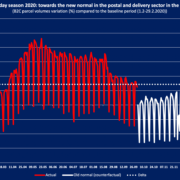As highlighted in UPU’s Postal Development Report, postal services are confronted to an unprecedented relevance crisis in spite of being one of the most globally connected and resilient infrastructures in the world. E-commerce couldn’t thrive without them and all of the Amazons and Alibabas would not be able to make their fortune. Warren Buffet once said that what Jeff Bezos did with Amazon was a miracle, but the true miracle was delivering billions and billions of online orders to nearly each corner of the connected planet (another half of it still remains unconnected though) over the last two decades or so, and that would not have been possible without the postal service. What would have become of these platforms without an infrastructure capable of delivering to each and every home? However, while no one doubts about the extreme relevance of Amazon, Alibaba or Ebay today, the same is not true for postal services.
The biggest relevance challenge, we believe, is that too many postal industry leaders are focused on the wrong transformational issues. Mail volumes declines are keeping them busy with cost reductions programmes, or diversification strategies throughout a number of postal activities, including financial services. As for the e-commerce boom, perceived as a tremendous opportunity for delivering a record number of packages year after year, it constitutes postal leaders’ main hopes and vision of the future of the industry. Postal and logistics services are not just exposed to direct competitive pressure by e-commerce platforms’ own delivery systems, but are, as well, remaining very far from these companies in modern consumers’ perception scale and are often the ones being blamed in case of terrible delivery experiences. Unfortunately, trust in some postal services has gone a long time ago and their relevance is at stake as never before.
The postal industry must come back to the basic and most fundamental questions regarding its very existence and relevance in the 21st century and avoid prioritizing other issues until the heart of the business is not reshaped. Luckily, history is here to teach us a few key significant lessons.
The first fundamental shift and dramatic transformation of the Post dates back to 15th century and the Renaissance era. The Thurn and Taxis family and its relatives were operating a pure transportation enterprise until they realized it was great for their business to pivot it towards servicing the Royals of Europe, speeding communication and enabling news and messages to circulate from one end to another at a time of raising European cultural awareness following the invention of the printing press. In these circumstances, instead of just being another transportation business, they started delivering a service, as never provided before. Their key move was designing an exclusive messaging delivery service customized to the needs of the sovereign.
In the UK, in 1840, this first critical postal development stage was revolutionized by Rowland Hill, through the introduction of stamps. Affordable posting tariffs that were prepaid by the sender only (before the introduction of the “penny black” stamp, recipients had to pay, on top of the senders, for their mail to be delivered) shifted delivery service, provided to a few wealthy ones, to one with a much broader use and increasingly accessible to the general population. Literacy was being broadened to wider segments of society through the different waves of industrial and political revolutions. In these circumstances, Hill’s postal revolution brought the fundamental notion of universalizing postal delivery.
Postal services were truly globalized and connected thanks to Heinrich von Stephan and Montgomery Blair and the creation of the Universal Postal Union in 1874. Coordination of all postal services operating in the world through a single postal territory supported the first wave of globalization of the end of the 19th century. The conditions for global delivery were set for the first time.
Almost another century was needed for postal services to be challenged and transformed. The development of express services, under the influence of pioneers’ such as Fred Smith, introduced the fastest delivery services ever supplied in human history. Those were made available thanks to great advances in air transportation in the 20th century at a time of accelerated development of the service economy and surge in global trade. Speed of postal services would be changed forever while tracking was progressively introduced and generalized throughout most logistics and postal networks…
… and then the world wide web came but the Posts didn’t fundamentally revisit their role. More than two decades after and they still mostly operate according to outdated delivery standards set before the Internet and e-commerce era. The relevance crisis has unfolded. An increasing development gap has appeared between the evolution of the general economy and the one of most postal companies in the world (see UPU’s figure below).

At UPIdo we clearly support a postal revolution as a way to regain relevance and trust for postal services in the 21st century. Technology can support this radical sector transformation today but a deep mindset change is needed among industry players.
Current postal value propositions must be totally revisited. Delivery, the starting point for any postal revolution in the past, should be at the very centre of next postal transformation, too. Neither diversification into other postal business lines nor cost reduction programmes in face of mail volume declines nor defining new categories of postal shipments for e-commerce can be the central issue. All main postal transformations in the past started with radical changes to the core, namely delivery conditions.
Delivery is one of the very key components of the value, or utility, of online ordering for e-shoppers and e-sellers today. People buy just so much more than a product or good online… they buy an overall convenience experience enabling them to access the greatest variety of products in the most seamless way ever. This calls for the greatest customization of delivery services ever. And this is where a first wall may be hit for an industry used to deliver in highly standardized ways, to be regulated according to common national or international delivery standards, and that has so far fail to understand the very uniqueness of each and every of its current and future customers in the era of big data and AI. Postal services are very far away from the notion of full customization of delivery services from first-to-last mile.
Yet delivery can only be radically reshaped by gaining a deep understanding of the uniqueness of postal customers, of the uniqueness of their life style and living conditions that cannot be properly integrated into today’s ultra-standardized ways of delivering e-commerce.
This is why the engineering of delivery must totally shift from being driven by a pure operational optimization process in response to operational costs to matching the greatest convenience expectations of customers instead.
Maximum delivery convenience would lead to maximum value in terms of business growth, sales and development for e-tailers and e-commerce platforms. However, these main partners of the postal and logistics industry, the Amazon, Alibaba and Ebays of this world, must also understand that the value experienced by its customers, thanks to highly customized postal services, is such a critical dimension of their business which in turn calls for postal and logistics companies to be genuinely rewarded, unlike today, for their success and failures in bringing this unique experience to customers.
In terms of pricing, this would mean that the providers of an increasingly tailored delivery convenience, namely the postal and logistics companies, must be paid according to the level of customized delivery experience they bring and its direct performance impacts on sales and revenues growth of e-tailers and platforms. Postal pricing cannot just remain as it is today, a simple delivery charge for a commoditized delivery service failing to recognize postal services key role in acquiring new e-shoppers and expanding the business of e-commerce platforms. Moreover, the current pricing practices around e-commerce delivery shipments, particularly at the international level, do not ensure the sustainability of delivery enterprises as long as they cannot more fully participate in the successful value creation generated by e-tailers and e-commerce platforms thanks to their vast delivery networks.
Therefore, postal and logistics companies must aim at maximizing customized delivery convenience and e-tailers and platforms should reward them for the huge impact this new shift in postal paradigm can have on their own business development. The greater the latest e-commerce business development impact, and the higher the price these platforms should pay to their postal and logistics partners. Because large platforms are those potentially benefiting the most from maximum “tailorization” and convenience of delivery services, they should also support most of the price burden. Pricing should be moved away from price per item to price per addressee benefiting from customized delivery conditions. Postal services could even become totally free below a certain number (for instance 1000) of addressees by sender per year. This would simply mean that most of the people would stop paying for sending items through postal services and benefit from increasingly tailored delivery service of their online orders. The core postal revenue generation would be driven by supplying the greatest delivery convenience and customization ever in postal history in a fair deal with large e-commerce platforms and senders. Once the core delivery would be reshaped, other strategic choices could follow, including the role of postal services and networks in areas such as payments or financial services. Without a clearly defined core delivery business, diversification is most likely to be unsustainable, lack of relevance and eventually fail.
The lessons from postal history support these relevant moves. By reshaping their basic transportation business, the Thurn and Taxis understood the critical importance of developing a service which was customized for the Empire: the modern Post was born. Today billions of postal customers are waiting for the greatest delivery convenience and customization truly matching the way they live, buy and exchange online. Rowland Hill introduced a postal pricing revolution to expand the use of these services in 1840. Today e-commerce platforms must be charged according to the impact of maximum delivery convenience on their successful business development and postal services stop being “commoditized”. Billing per addressee or per address, according to the level of delivery convenience provided, should be considered and replace the current tariff per shipment. Under a certain number of addressees per sender and per year, postal services should become free. The creation of the UPU also tells us a lot. It set up the conditions of global delivery through a single postal territory during the first wave of globalization of the 19th century. Today no distinction should be operated between national or international postal customers: there are only global postal customers. Segmenting national and international postal services is irrelevant in the age of social networks where people are irreversibly bound across borders by trade and ideas. Would a social network divide international and national users? Finally, after express services sped up delivery over the course of the 20th century, the age of predictability of delivery (knowing what will be delivered when) will give a sense of ever faster delivery services and save billions and billions of waiting hours to senders and recipients alike, virtually matching the instantaneous gratification feeling of buying in a physical store.
To achieve these new postal relevance goals, the right strategic mindset is necessary. This is no evolution: it is a revolution. But the key drivers of this revolution are not technological. Big data is not the revolution for the Post. Artificial Intelligence is not the revolution for the Post. Blockchain is not the revolution for the Post. The Internet of Things is not the revolution for the Post. Drones or robots are not the revolution. The revolution is in a new mindset for the industry. What makes the world a better place are changes of mindsets. UPIdo and other highly relevant technologies are there to fully support them.
Ref. and graphic: http://www.upu.int/uploads/tx_sbdownloader/postalDevelopmentReport2018En.pdf

 UPIDO AG
UPIDO AG


